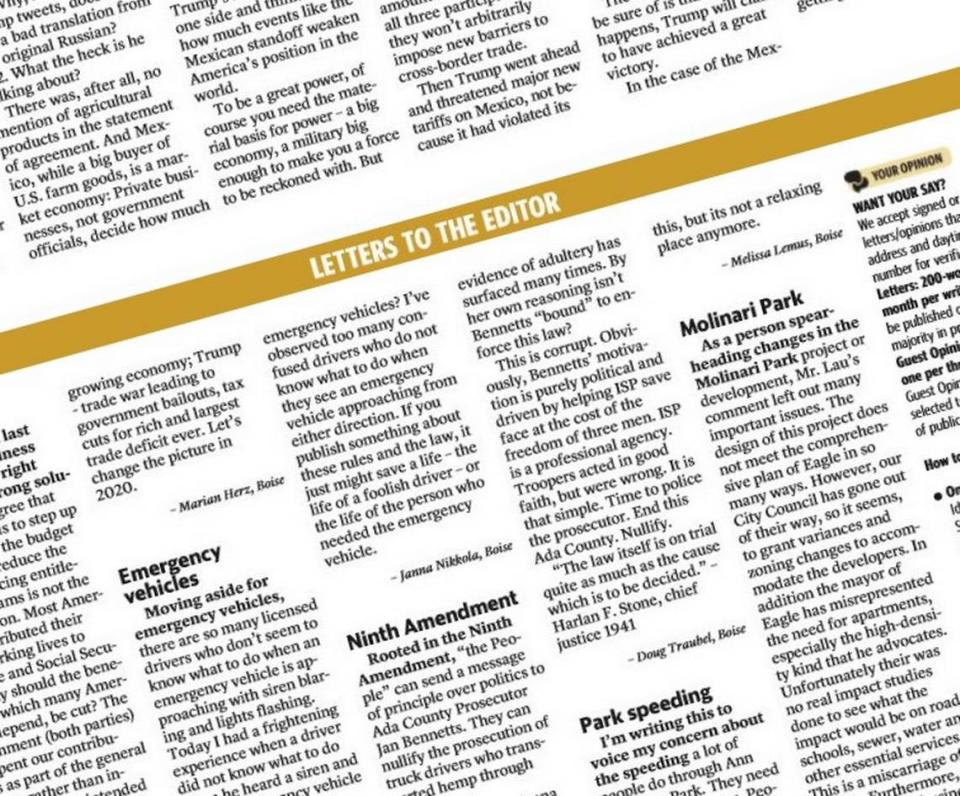Letters to the editor: reflective markings, data and policy, and dam removal

Reflective markings
While driving my daughter to school, it was raining on Highway 55. I could not see the lines in the road along an S-curve and had to slow down to avoid veering off into the ditch.
With all the money our legislature has been glad-handing each other about, they need to invest in highway striping paint that incorporates retroreflective glass beads. Glass beads significantly increase the reflectivity of paints on the road, which in turn significantly improves their visibility and consequently driver and pedestrian safety. Glass beads are the only road marking additive that causes retroreflection, sending more of the headlight beam back to the driver. Consequently, they make road markings at night time appear five times brighter than road markings that do not contain glass beads.
On a similar note, the lack of guard rails along some of Idaho’s serpentine roads have contributed to unnecessary deaths. The Boise County tragedy where a man recently ran his vehicle off Highway 55 and into the Payette River could have been prevented by some guard rails.
Before our leaders start debating where and how to spread Idaho’s wealth around, I suggest a few crumbs be spent on highway safety.
Terry DeLaney, Eagle
Data and policy
In Dr. Crabb’s Jan. 6 article, he warns of the unseen impacts of governmental intervention and encourages readers to realize there is an opportunity cost associated with every decision. Versus warning readers of selection bias or providing arguments against elements in Biden’s plan, he states we should not “be swayed by data in a policy debate” because governmental intervention can have unintended consequences and unseen opportunity costs.
Governmental intervention can effectively solve big problems. For example, human use of chlorofluorocarbons was causing an expanding hole in our ozone layer, which was reversed through governmental intervention. The future cost of inaction likely exceeded the cost of intervention, and policymakers heeded the warnings of the scientific community and acted with voter support to craft effective policy.
Will a transition to clean energy protect the prosperity of future generations? Should we redistribute wealth to achieve certain social goals? Given there is no crystal ball to view the outcome of any binary decision and to reinforce the spirit of Dr. Crabb’s argument, we need to approach governmental intervention with prudence. With that said, we should not disengage from policy debates nor stay bound to a position when mounting evidence calls for a change.
Douglas O’Coyne Jr., Meridian
Dam removal
My name is Garen Gudgell, and I am an 8th grade Native American at Sage International School in Boise, Idaho. I am writing this on the topic of the Lower Snake Dams to explain to the public how these dams being in place are a massive issue in the lives of the Shoshone, Bannock, Paiute, and the Nez Perce tribes. These tribes have been living in Idaho for well over 400 years, and salmon are a part of their culture.
“For the past five decades, the Shoshone-Bannock Tribes have been working to restore the Snake River and our salmon runs. With the dams in place we have experienced impacts to our culture, spirituality, and our way of life; we need to change the system in order for salmon and our people (Newe) to survive. Removing the Lower Four Snake River dams will help restore our fisheries, protect our culture and create a better future for our Tribal membership,” (Shoshone-Bannock Tribes 2021).
This quote from Claudeo Broncho, a tribal elder in the Shoshone-Bannock tribe, highlights perfectly the struggles that the natives are going through at this time. I challenge Idahoans to look into this topic and speak up for this issue.
Garen Gudgell, Boise

 Yahoo Movies
Yahoo Movies 